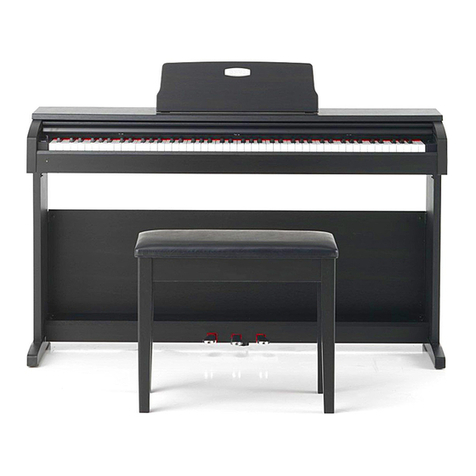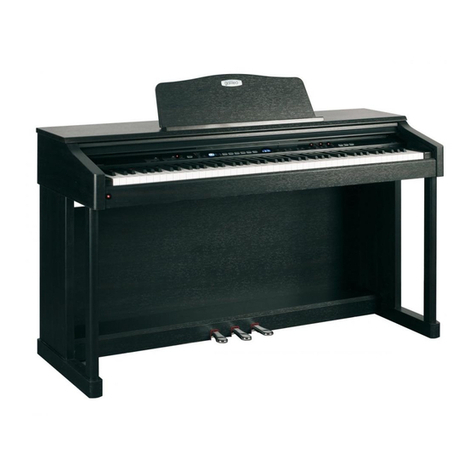7
Concerto
User Manual
6
3. THE PEDALS
The instrument has three pedals which allow you to add
expression to your performances. The effects and noises
generated by operating these as pedals are as lifelike as
possible, to provide optimal simulation of the sounds of a real
acoustic piano.
•DAMPER Pedal: when this pedal is pressed, the notes
played have no release, so they will sound until the strings
cease to vibrate, like in a real piano. When the pedal is
released, the notes being played will stop sounding at once.
As well as this, with the pedal pressed and with the three acoustic piano voices (Grand
Piano, Classical Piano and Rock Piano) active, the instrument simulates the
“sympathetic” strings vibration and resonance, and the noise of the damper. Both these
effects can be regulated using functions F5.2 and F5.3 in the Function menu (point
14.6). The pedal operates as a continuous cotroller, so if it is only partially depressed,
the level of these effects will be reduced.
•SOSTENUTO pedal: like the Damper, this pedal only annuls the release of the notes
pressed when the pedal itself is operated. Subsequent notes will sound in the normal
way. When the pedal is released, the notes which are still sounding because of the
Sustain will stop. This pedal is useful when you wish to sustain a chord (meaning that
the pedal should be depressed with the notes of the chord also depressed), and then
play subsequent notes in the normal way.
•SOFT Pedal: The Soft pedal reduces the volume of the notes played when it is pressed.
In the J.Organ 1 and 2 voices, this pedal selects the speed (Slow-Fast) of the Rotary
effect. The F5.1 function (point 14.6) in the Function menu also allows you to enable
the Soft pedal to provide the sequencer Start-Stop commands.
4. [HOST SELECT] selector: selector for setting the port ([MIDI] or [TO HOST]) to be
used for transmitting and receiving MIDI data. For further information about this function,
refer to chap. 15.
5. [MIDI] connectors: these three connectors allow the piano to be connected to other
MIDI instruments. These connectors allow:
-[IN]: reception of MIDI data transmitted by other units.
-[OUT]: transmission of the MIDI data generated by the piano.
-[THRU]: transmission of the MIDI data received by the [IN] connector for cascade
connection with other units.
Set the [HOST SELECT] selector on “MIDI” to transmit and receive data by means of
the [MIDI] connectors.
6. [AC INPUT] connector: connect the power supply lead supplied with
the instrument to this connector.






































